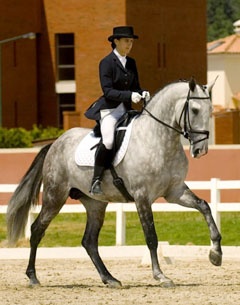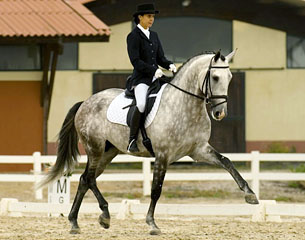
We can train every day in pursuit of achieving that feeling of true harmony with our horse, but to get a sense of the sensitivity and submissiveness of our horse/rider relationship, we must put it to the test!
The decision of when and where to begin the competition career on any horse is tricky, but particularly with young horses.
Putting your work into a controlled environment is an important part of training, as it tests your horses ability to cope with the added stress and excitement of competition. More importantly completing a test helps riders determine not only whether their horse can make the transitions correctly, but whether he is submissive enough to make them correctly...on demand!
My now 6 year old Lusitano Batialo had been recently experiencing a phase of "I am going to take over," shortly followed by a nice kick up in the air, or sudden take off in what ever direction he felt served his purpose...trying to get out of the work. So the move into competition was a good test, to see if my disciplinary techniques had worked not only in training, but in an arena where I needed his complete focus and attention.
To overcome these issues at home, instead of attempting to be more forceful like the stronger male riders can, I had to work with what I have. There was no way I could use physical strength to overcome Batialo's sudden bursts of power and so I needed to outsmart him in other ways. I found that his intelligence was all the help I needed to aid me in my chosen method to win back his submission and control.
I decided that every time he played with me, I would pinpoint the exact moment he took-over and what ever it was he was trying to get out of, I made him do that exact thing, ten times more. For example, if he kicked out or tried to take off when I attempted to sit him back in the canter, then i would complete 8 metre voltes at the canter until he accepted the move into the collection. If he tried to take over in the shoulder-in, we would do shoulder-in on the circle until he gave up, if he didn't want to stay round and supple in the counter canter, we would do transition to and from the counter canter until he was tired. It did not take long at all for him to realise that the minute he was naughty, he would be made to continuing doing the thing that he was trying to avoid until he accepted it! And within the space of two weeks I had him back, completely submissive and ready to respond to my aids and not his own free, and very powerful, will.
To test this relationship, to see if we were working together, a competition was the perfect chance. The first decision is when to first take your horse into the arena. This is difficult as each situation of horse and rider is completely different. It can be a great idea before actually entering in a test, to pack your horse up and travel to a local competition and just ride him there, to experience him in the competition environment. However not everyone can afford such luxuries, but for me the decision of when to enter a test came about through good opportunity.
The stable where my horse is kept decided to run a pool competition, offering local riders the chance to ride a test, under test conditions, unofficially. So that also answered the next question of where my first test would take place. This was very fortunate, but normally you need to choose somewhere local, with good facilities and not too big for your first go! I say to choose somewhere local not only cause it lowers the stress of transport etc, but it also allows you to keep one golden rule in mind!
If you arrive at the competition and begin the warmup and your horse is being a total nut, don't do the test! It is far better to scratch and lose the money for entry, than have your first test experience be a bad one. So if you know on the day before you go in that there is no chance it will go well, then don't do it. Ride him harder outside, get him to relax and then try again next time! Horses know instinctively that you can't discipline them properly in the arena and is better that he never learns he can take over, than have to retrain him to enjoy completing a test.
Next is the warm-up! You can never allow too much time to warm-up, particularly if this is your horses first competition. Anyone who tells you you will tire your horse out, hasn't thought about those thousands of times when you are coming to the end of a tough lesson, and you think your horse is buggered when suddenly a car hoons up the driveway and you find yourself being launched into the nearest tree. On a day of competition a horse will always find extra energy and better to go in the test and you have to ride him a little more, and then roaring around out of control!
 So my first test was easy to get to, as it was at my front door, and I allowed well over an hour for the warm-up, just to be sure I had the driver's seat on not him! I also allowed time to walk around the arena before the competition started so he could look at the "new" pot plants and tables. I also learnt one interesting lesson: don't decide to go to the toilet 15 minutes before the test, or if you do, don't let someone who seems like a horse person, but really isn't, hold your horse. I came out of the toilet to the soft sound of a galloping Batialo, who had very quickly worked out the man was not a horse person, and decided to take advantage of his looming freedom. Anyway, i caught him fairly quickly and luckily within minutes he was calm and back on my aids in the warm-up arena.
So my first test was easy to get to, as it was at my front door, and I allowed well over an hour for the warm-up, just to be sure I had the driver's seat on not him! I also allowed time to walk around the arena before the competition started so he could look at the "new" pot plants and tables. I also learnt one interesting lesson: don't decide to go to the toilet 15 minutes before the test, or if you do, don't let someone who seems like a horse person, but really isn't, hold your horse. I came out of the toilet to the soft sound of a galloping Batialo, who had very quickly worked out the man was not a horse person, and decided to take advantage of his looming freedom. Anyway, i caught him fairly quickly and luckily within minutes he was calm and back on my aids in the warm-up arena.
As this was our first test I decided to set myself some goals. I wanted to go in there and maintain the rhythm, control each movement, not hassle him too much, but complete a calm well rounded test that we both would enjoy! I didn't want perfection, I didn't want full blown mediums and i didn't want to fight with him or push him too hard. The minute I entered the indoor I was delighted to discover he was of the "look at me" variety and not the "hahahaha in here she can't do anything to stop me" breed of horse. He wanted to impress and I have to say it was the most fun I have ever had in a dressage arena.
Entered in Medium level test, Batialo was still a little under that level of training, but in Portugal the level corresponds with the horses age, so we gave it a shot. The walk pirouettes were interesting, as we hadn't really trained them, but other than that we did what we set out to: enjoy a relaxed test and it gave him a first experience of "well that was easy"!
So we managed a score of 66% and from the comments I need to work on accuracy, collection,transitions - well, really everything that I will have to work on forever.
Test riding can be a lot different from training and while you must remember all the important things you employ during the everyday work, the test gives you little time to react and you must always remember to breath and keep your cool. If you make a mistake, don't panick, but leave it immediately behind you and think about what is next!
As a young rider I have accumulated many tips on test riding, but five golden rules have stuck with me through the years, from my tests on my shetland as a 5 year old, to this day!
Five golden rules of test riding
- Dream it - Before the day of competition ride the test in your head as many times as you can. Imagine yourself doing it, think about what could go wrong, what you will do, when you will prepare for next movement, what you need to concentrate on the most. Right before you go to sleep, picture yourself riding up the centreline, this is medically the optimum time for memory retention, and also a great way to put you to sleep, lol.
- Use your corners - the corners in the test are your lifeline, use them, ride into them, balance the horse and sit him back, ensure you have control of the outside shoulder by using inside leg into outside rein to half halt him. If you think it takes two steps to get around corner, aim to take ten, use this time to correct the balance, reestablish a good rhythm and THINK about what is next!
- Think about the next before finish the last -Do not get to the end of the shoulder-in and then think, what do i do now??? The minute you have established one movement, start to prepare for the next, eg, put the horse in shoulder-in, establish it, then think, at the end of this movement i must go straight before the corner, i will use my corner to prepare for the medium, I will ensure i have control of the outside shoulder as i come out of the corner, and i will not ask too much in the medium.
- Don't give what you can't get back - Do not fly across the arena in your very best extended trot, if you know you cannot control the transition back! Only allow the horse to produce as much impulsion in the test as you know you can safely half-halt back from at the end. Many a time have I seen someone take their first diagonal, and fly across with an 8 extended, and then, unable to get the control back at the end, execute an out of control and in-submissive test.
- Finally: Breathe, Relax and smile! Sounds simple, but getting all caught up in the test criteria will drive you crazy, just remember it is just a display of your work, and that at end of the day you and your horse need to enjoy it! It has to be a good experience for your horse.
Text by Sarah Warne
Related Links
Part I: Classical Training Defined by a Multi-national Team of Young Riders
Part II: Adapting the Training Once You Start Competing
Part III: Progression, Perfection, and Peace
Part IV: A Rider's Ultimate Test, Retraining a Horse